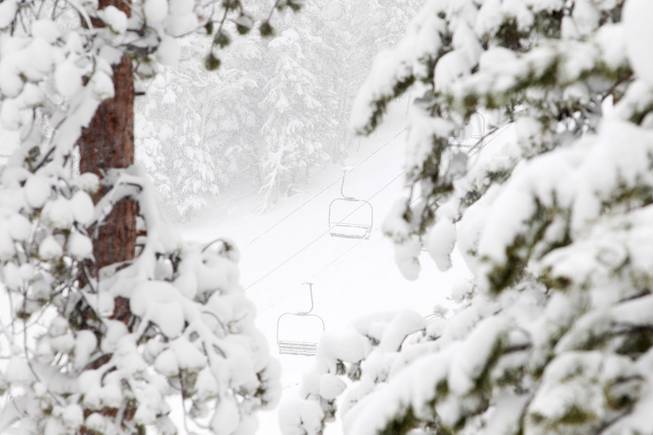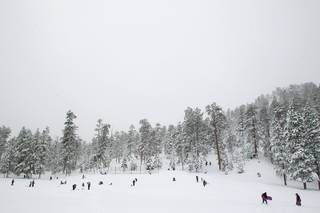
Sam Morris / Las Vegas Sun
Chair lifts at Las Vegas Ski and Snowboard Resort sit still before opening day while snow falls on Mount Charleston on Saturday, Nov. 23, 2013.
Wednesday, Dec. 4, 2013 | 2 a.m.
Damage from this summer’s fire on Mount Charleston already has led to unexpected flooding that damaged homes in the area. Now, with heavy snows beginning to fall on the mountain, officials are warning the loss of vegetation could lead to an increased risk of avalanches this winter.
The threat of avalanches is a part of life on the mountain, but usually the destructive cascades of snow are limited to known avalanche zones, which funnel debris safely down the mountain.
With portions of Mount Charleston now bare after this summer’s Carpenter 1 fire, which burned 27,881 acres, a variety of factors mean avalanches in those zones are more likely than in previous years.
“Because you’ve lost vegetation, you probably have an elevated risk of avalanches,” said Jim Hurja, a soil scientist with the U.S. Forest Service in charge of recovery efforts on Mount Charleston’s burned areas. “It’s all going to depend on snow depth, what kind of snow loading you get, the slope and how much vegetation is there to anchor that snow.”
The loss of vegetation affects the risk for avalanche in several ways, Hurja said. Fewer trees means more snow will reach the ground in certain areas, leading to a potentially dangerous buildup. The snowpack will also be exposed to more direct sunlight due to the lack of trees, which could lead to a melting and refreezing that can lead to avalanches.
“A lot of times, avalanches occur because snow underneath has melted and frozen, leaving an area where it can slide off and break loose,” Hurja said, adding it could take up to 10 years for vegetation destroyed by the fire to return.
Hurja said residents and visitors to the mountain don’t need to panic about avalanches, but they need to be aware of the risks and heed Forest Service warnings.
Mount Charleston shouldn’t have any new areas considered at risk for avalanches, he said. Instead, the fire increased the risk in already identified avalanche zones, like the area around Cathedral Rock in Kyle Canyon, which is currently closed to visitors.
Quantifying the risk of avalanches or how the fire affected the situation is difficult, Hurja said.
“We may not have any avalanches. That’s very possible,” he said. “It all depends on the weather.”
So far, Mother Nature is doing her best to test the conditions, dumping an abnormally large amount of snow on Mount Charleston even before the onset of winter.
A storm dropped about 20 inches of snow on the mountain over several days starting Nov. 22, nearly triple the amount the area typically sees in November, said National Weather Service meteorologist Chris Stumpf.
It’s impossible to tell whether the early snowfall portends a wet winter on the mountain, Stumpf said, but the area typically sees between 17 inches and 28 inches each month between December and March.
The November snowfall triggered an avalanche warning from the Las Vegas Ski and Snowboard Resort, largely because the resort had yet to open and its avalanche monitoring teams weren’t in place, said spokeswoman Maria Norero.
“It was a normal avalanche risk that any ski resort gets when they get new snow,” Norero said. “We have a snow safety team that checks conditions every day on the mountain when we’re open. That team wasn’t in place when we got all this snow, and we wanted to warn people.”
The resort was the site of a deadly avalanche accident in 2005 that killed a 13-year-old boy who was swept off a ski lift and buried in several feet of snow. The resort uses explosives, including a modified artillery gun, to clear snowpack that could be vulnerable to sliding.
Lee Canyon, where the resort is situated, was not affected by this summer’s fire and is not thought to be at an increased risk of avalanches.
Norero said the threat of avalanches was always a concern, but they don’t occur that often.
“We tend to have not that much avalanche danger,” she said, “because we don’t usually get that much snow at once.”


Join the Discussion:
Check this out for a full explanation of our conversion to the LiveFyre commenting system and instructions on how to sign up for an account.
Full comments policy